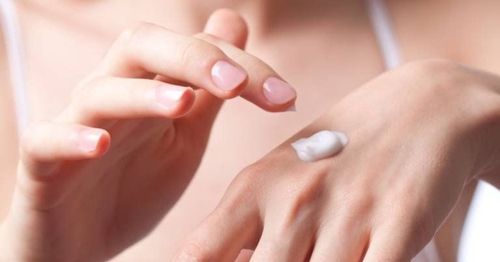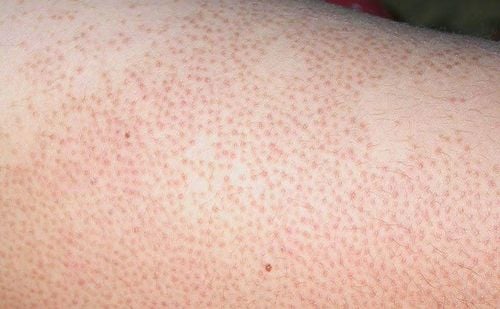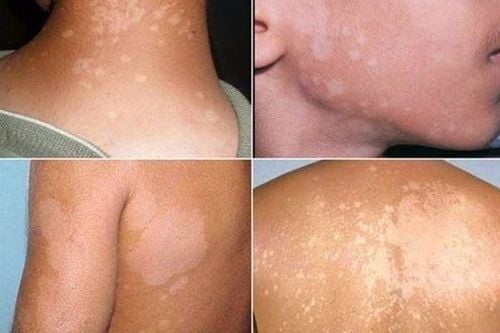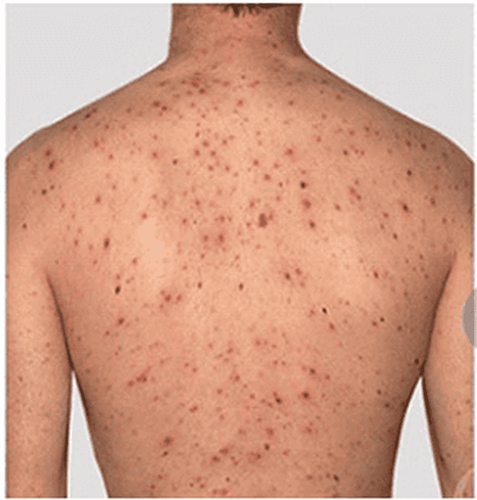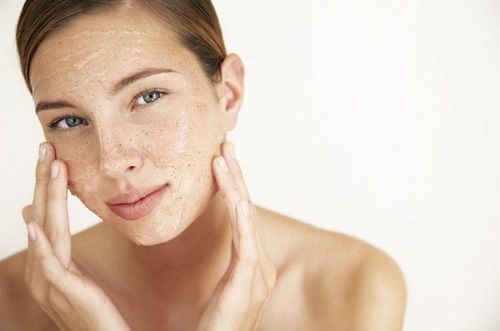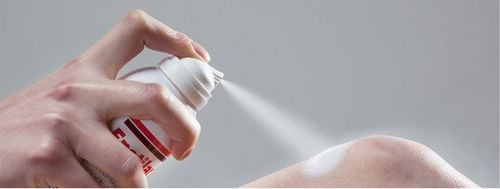This is an automatically translated article.
Back folliculitis is not a dangerous condition, but it is a common problem, affecting aesthetics. In some cases, the inflammation of the pores on the back often recurs or lasts for a long time, making the patient tired.
1. What is back folliculitis?
A hair follicle is a small sac, covering the hairline under the skin and accessing the sebaceous glands, it can appear anywhere on the body, including the back (but excluding the palms, soles, etc.) feet, lips and mucous membranes). Each hair follicle consists of 3 parts: the mouth of the hair follicle connects to the surface of the skin, the neck of the follicle - the part that slightly constricts below the mouth of the hair follicle and the longest part that goes deep into the dermis of the skin.
Folliculitis in general or inflammation of the pores on the back in particular occurs when the hair follicles on the back are infected, most commonly folliculitis caused by infection with Staphylococcus aureus (staphylococci), in addition to inflammation may also occur. Folliculitis caused by other fungi and bacteria, viruses and some other variants of folliculitis.
2. Symptoms of back folliculitis
Signs and symptoms of back folliculitis can vary depending on the type of infection:
2.1. Superficial folliculitis Superficial folliculitis on the back includes all types of inflammation in the oral portion of the hair follicle, which can cause small, clustered bumps around the hair follicle, vesicles, or pus with scabs from ruptured acne. leaving, skin erythema, itching, pain.
2.2. Deep folliculitis on the back Deep folliculitis is inflammation from the inner part of the skin of the hair follicle and affects the entire hair follicle. At this time, you may experience the following symptoms:
Swollen hair follicles; Blisters or pus; Scaly, painful, may leave scars.

Viêm nang lông ở lưng khiến các nang lông sưng tấy
3. Causes of inflammation of the pores on the back
Skin is home to more than 500 different species of bacteria, including beneficial and harmful bacteria for the skin. These two types of bacteria interact with each other to create a microbial balance on the skin to help the body fight off threats from outside. But when there is an impact factor that upsets this balance or when the local skin is damaged leading to a decrease in the local immunity of the skin, the inflammation of the skin components is likely to be high. appear. Hair follicles are also a component of the skin and will be affected in the same way.
The common causes of inflammation of the back pores are:
Strong or frequent friction caused by wearing tight clothes, rough fabrics against the skin of the back; Shave/remove back hair regularly; The back skin is not cleaned regularly or is rubbed too hard, causing the back pores to be damaged; The sebaceous and sweat glands on the back are overactive, making the pores clogged, creating a favorable environment for bacteria, fungi, and viruses to multiply; Inflammation of the components near the hair follicle such as dermatitis , acne on the back; Injuries to the skin on the back such as scratches, surgical wounds, ...; Ingrown hairs curl inward leading to dorsal folliculitis; Due to too hot bath: Hot shower causes skin as well as hair follicles to be irritated. Moreover, in the hot tub, there is also Pseudomonas bacteria that causes back folliculitis. Due to long-term use of antibiotics, steroids or steroid products; Diabetes, chronic leukemia, organ transplants, and HIV/AIDS may increase the risk of back folliculitis due to a weakened immune system.
4. Treatment of back folliculitis
Back pore inflammation is mild, no pustules have appeared, can be completely treated at home. However, if the folliculitis on the back is severe, the symptoms are more severe (inflammation of the folliculitis is widespread, pustules, boils, high fever, fatigue, ...) or the folliculitis persists and recurs. If it is replayed many times, you should go to medical facilities to be examined and given appropriate treatment methods.
4.1. Back folliculitis and home treatment Warm towel: One of the simplest and very easy to implement, effective ways to treat folliculitis on the back is to apply a warm towel. This will help your back reduce discomfort, reduce swelling and pain caused by folliculitis, and promote drainage to eliminate toxic components. Use a soft towel dipped in warm water of 60-70 degrees Celsius, squeeze out the excess water and apply on the back for 15 minutes. You can do this method 2-3 times a day. Back folliculitis and treatment with coconut oil: Using coconut oil is one of the methods applied quite a lot because of its benignity and effectiveness. Coconut oil can help the skin on the back reduce water loss, soften the skin, support the healing of damage and regenerate cells to help the inflammation of the pores on the back recover faster. Use 2-3 tablespoons of coconut oil to apply a thin layer directly on the inflamed back hair follicles, leave for 10-15 minutes and then rinse with cool water. Treatment with betel leaves: Betel leaf is not warm, spicy, has a strong aroma, has the effect of helping to circulate blood, inflammation, antiseptic, except for rheumatism. Betel nut oil no longer contains phenol derivatives and natural antibiotics that help reverse the symptoms of back folliculitis. Put 1 handful of betel leaves + 2 tablespoons of granulated salt in 2 liters of water to boil, use boiled water to wash and sanitize the back area. Folliculitis on the back and treatment with coffee grounds: Coffee grounds have the ability to antibacterial and remove dead cells, clean pores. To perform this method, you need to prepare about 4 teaspoons of coffee grounds + 4 tablespoons of unsweetened fresh milk, mix well and apply this mixture on the back skin to be treated. Just apply and massage gently and wait for about 20 minutes, then rinse with water. However, it is not recommended that you use these home remedies for folliculitis that is already accompanied by severe skin lesions, inflamed nodules that burst, pustules, and boils.

Dầu dừa có thể được ứng dụng trong điều trị viêm nang lông ở lưng
4.2 Back folliculitis and how to treat it with western medicine Drug treatment is prescribed by a specialist and depending on the cause, the severity of the back folliculitis, the drugs are usually used are:
Topical or oral antibiotics; Topical or oral corticosteroids; Oral antifungal; Anti-itch (anti-itch) medicine applied or taken by mouth. When treating patients with severe inflammation with large boils, doctors can intervene by making a small incision to help reduce pain, speed up recovery, and limit scarring.
5. Preventive measures for back folliculitis
Although it is not possible to completely prevent back folliculitis from occurring, these measures can help reduce your risk of getting the disease:
Take a bath and keep yourself clean, especially on your back; Wear loose, airy clothes, limit wearing materials that do not absorb sweat; Limit shaving and hair removal at home. Shaving should be replaced with an electric knife, or renew the razor before use; change the method of hair removal safely, more thoroughly; Drink 1.5 to 2 liters of water/day; Eat healthy with a nutritious diet, lots of fruits and vegetables, and limit fatty and sweet foods. Do not arbitrarily use medicine on the back area without a doctor's prescription. In short, back folliculitis is not a dangerous disease, but it greatly affects the aesthetics, health and life of the patient. The treatment of folliculitis in general will prevent complications of the disease such as scars, boils, etc., to help patients gain confidence and ensure quality of life.
Please dial HOTLINE for more information or register for an appointment HERE. Download MyVinmec app to make appointments faster and to manage your bookings easily.




